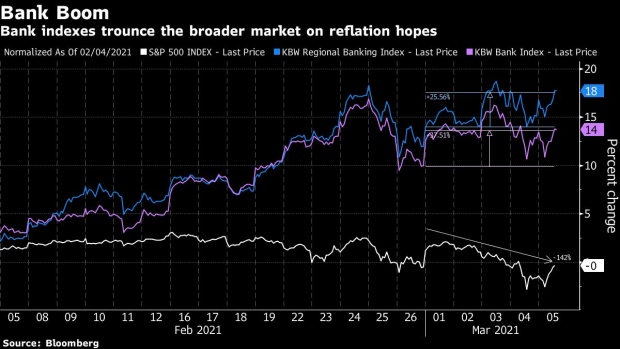Mar 5, 2021
Bank Stock Rally Shows Few Signs of Faltering Soon
, Bloomberg News

(Bloomberg) -- Bank stocks are on a tear this year, boosted by reopening optimism as the vaccine rolls out across the U.S.
Investors are betting that more lending, more deals and more consumer spending are yet to come. The potential for fresh stimulus and infrastructure and other massive projects should lift their shares. Even so, while higher yields in a low-interest-rate environment are good for banks, sharp jumps have rattled global markets this week.
The KBW Bank Index has surged 21% this year as some of the biggest banks like JPMorgan Chase & Co., Bank of America Corp. and Citigroup Inc. posted double-digit gains.
Analysts have turned increasingly bullish on the sector. Goldman Sachs called out regional banks in particular -- up 31% -- as likely to outperform with a steeper yield curve, more lending and a shift toward higher capital returns. Raymond James said discussions with bank executives supported a bullish stance on the stocks, as liquidity and government stimulus support positive credit trends.
Passing Storm
“These stocks have had a great run year-to-date,” RBC analyst Gerard Cassidy said in a phone interview. “If you’re looking at them over the next 12 to 18 months, they’re still reaping meaningful upside.” Earlier this week, he highlighted good credit trends, noting that U.S. banks had prepared for a major credit storm and instead, maneuvered through a mild one.
Some research firms lifted earnings estimates and price targets. Morgan Stanley’s Ken Zerbe raised share price forecasts by 9% on average for midcap banks and expects to see a small impact on earnings per share to start and accelerate over time. He increased Signature Bank’s stock target by 30% and SVB Financial Group’s by 11%.
Wells Fargo & Co. analyst Mike Mayo asked, “what’s not to like?” when it comes to bank stocks, highlighting three turning points:
- November’s news about the efficacy of Pfizer Inc.’s Covid-19 vaccine.
- The Federal Reserve allowing for more stock buybacks in December.
- January’s Georgia Senate elections, which paved the way for more government stimulus.
Even so, the rally isn’t flawless and there are reasons for some caution.
The main bank index shifted from gains to losses and back again on Friday, after a better-than-expected jobs report bolstered confidence in the economy, closing up 1.7% as wrangling over stimulus continued, while yields on 10-year Treasuries touched 1.6%. Higher rates allow banks to charge more to borrowers, boosting lending margins on products from credit cards to mortgages
If interest rates head too high, investors will start to worry about the impact on companies and consumers. Plus, there are concerns about still-tepid lending, with demand yet to materialize as the financial system remains awash in liquidity.
New Rivals
And banks face ever-tougher competition from both established and emerging fintech companies. JPMorgan Chief Executive Officer Jamie Dimon pointed to Walmart Inc.’s financial technology plans when asked this week about the competitive environment.
Another pitfall could be the wobbly values in commercial real estate, a big profit contributor for smaller banks. Federal Reserve Chair Jerome Powell told Congress Feb. 23 he’s keeping an eye on commercial property because of the banking system’s exposure. Prices “appear susceptible to sharp declines, particularly if the pace of distressed transactions picks up or, in the longer term, the pandemic leads to permanent changes in demand,” the Fed said in a Feb. 19 report.
“There will be a point when banks overshoot the broader market,” RBC’s Cassidy warned. “There was an expression 20-plus years ago, where it would be bank ‘heaven’ if the banks traded at market multiples and that clearly was an overstep for people who believed that at the time. Should that reappear in this cycle, that’s when it’s overdone.”
©2021 Bloomberg L.P.





